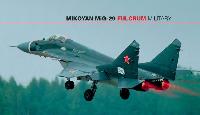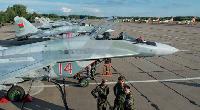Фотографии
-
In the early 2000s, RSK MiG promoted a MiG-29 life extension programme for up to 4,000 hours and 40 years, compared with the type's original 2,000 hours and 25 years life. The upgrade was purchased by some export customers including the Slovakian and Bulgarian Air Force. This photo shows a single-seat Slovakian aircraft in a digital camouflage applied as a part of the upgrade programme, which also included integration of Western navigation, communication and IFF avionics.
Самолёты на фотографии: МиГ МиГ-29 - Россия - 1977
-
The MiG-29 was conceived as a light-weight agile fighter with BVR capability. The aircraft can be armed with up to six missiles - two BVR R-27Rs with semi-active radar-homing seekers and four heat-seeking R-60s or R-73s for close air combat. The missile payload is complemented by a 30mm GSh-301 cannon with 150 rounds.
Самолёты на фотографии: МиГ МиГ-29 - Россия - 1977
-
Самолёты на фотографии: МиГ МиГ-29 - Россия - 1977
-
Самолёты на фотографии: МиГ МиГ-29 - Россия - 1977
-
The Schtel-3UM helmet-mounted cueing system is slaved to the radar/IRST and missile seeker heads for accelerated cueing at off-boresight targets of the highly-agile R-73.
Самолёты на фотографии: МиГ МиГ-29 - Россия - 1977
-
One of the two MiG-29K prototypes built in the late 1980s was used as the baseline for developing new shipborne Fulcrums for the Russian and Indian naval air arms.
Самолёты на фотографии: МиГ МиГ-29К - Россия - 1988
-
Although marketed as a multi-role aircraft, the big-spine MiG-29SMT operated by the Russian Air Force cannot employ laser-guided bombs or air-to-ground missiles because it lacks a suitable targeting and laser designation pod.
Самолёты на фотографии: МиГ МиГ-29СМТ - Россия - 1997
-
Регистрационный номер: RF-92925 All 28 MiG-29SMTs currently operated by the Russian Air Force were inherited in 2009 and 2010 from the cancelled Algerian contract.
Самолёты на фотографии: МиГ МиГ-29СМТ - Россия - 1997
-
The initial full-standard MiG-29SMT demonstrator made its first flight after being converted from the MiG-29SE demonstrator on July, 1998. It is shown armed with an active radar-guided RVV-AE missile and a Kh-29T TV-guided air-to-surface missile.
Самолёты на фотографии: МиГ МиГ-29СМТ - Россия - 1997
-
Регистрационный номер: KBU3301 Indian Air Force MiG-29UPG prototype KBU3301 with an inert Kh-35E anti-ship missile was used for aerodynamic trials. The aircraft's new dorsal tank pack, a component of the SMT and UPG upgrades, is clearly visible in primer paint.
Самолёты на фотографии: МиГ МиГ-29СМТ - Россия - 1997
-
МиГ-29СМТ теперь оснащен авионикой, созданной в Раменском приборном КБ
The MiG-29SMT's cockpit incorporates two multi-function colour displays and numerous analogue instruments in the centre of the console.Самолёты на фотографии: МиГ МиГ-29СМТ - Россия - 1997
-
A pair of MiG-29UBs from the Lipetsk training centre roll-out after landing at Kubinka Air Force Base in July 2013.
Самолёты на фотографии: МиГ МиГ-29УБ - Россия - 1981
-
The MiG-29SMT's arsenal of unguided and guided weapons includes the Kh-31A high-speed anti-ship missile and a KAB-500Kr 1,100 lb (500kg) TV-guided bomb, as seen on the right side of this photo.
Самолёты на фотографии: МиГ МиГ-29 (9-13) - Россия - 1984
-
A group of Belorussian MiG-29s at Machulishi Air Force Base in the Minsk region assigned to the 61 Fighter Base prepare to conduct a flypast over Minsk on July 3, 2014.
Самолёты на фотографии: МиГ МиГ-29 (9-13) - Россия - 1984
-
A close-up of the two main air-to-air missile types used by the classic Fulcrum: the R-27R SARH-guided BVR missile suspended inboard and the highly agile, heat-seeking R-73 on the other two pylons.
Самолёты на фотографии: МиГ МиГ-29 (9-13) - Россия - 1984
-
The MiG-29’s Klimov RD-33 is efficient in cruise flight and an impressive afterburner power rating but suffers from a low TBO and produces a pronounced smoke trail on transient modes between idle and military power settings, as illustrated by these humpback RuAF MiG-29s at Lipetsk.
Самолёты на фотографии: МиГ МиГ-29 (9-13) - Россия - 1984
-
The lightweight R-60 air-to-air missile is used by a number of MiG-29 operators mainly for practice firings: it has been superseded by the more capable R-73.
Самолёты на фотографии: МиГ МиГ-29 (9-13) - Россия - 1984
-
The cockpit of the classic Fulcrum is populated by numerous analogue instruments which pilots believe are better ergonomically than those on its MiG-21 and MiG-23 predecessors.
Самолёты на фотографии: МиГ МиГ-29 (9-13) - Россия - 1984
-
The MiG-29K, a dedicated shipborne multi-role fighter, is currently being produced for the Indian and Russian naval air arms.
Самолёты на фотографии: МиГ МиГ-29К/КУБ - Россия - 2002
Статьи
- -
- News
- A.Mladenov - Fulcrum /Military/
- A.Mladenov, K.Grozev - Ukraine's Helicopter Setbacks /Military/
- D.Isby - Thunderbolt Twilight /Military/
- D.Oliver - Reaching for the Heights /Commercial/
- H.-P.Grolleau - Tigre's Progress /Military/
- I.Harding - Dutch Neptune's Return /Military/
- M.Ayton - Inaugural Deployment /Military/
- M.Ayton - Rocket Ship /Military/
- M.Broadbent - Boutique Brunei /Commercial/
- R.Niccoli - Italy's Black Cats /Military/


















